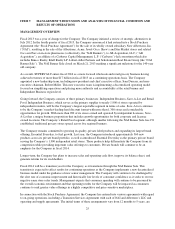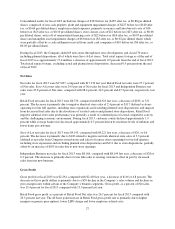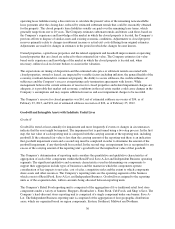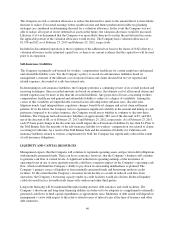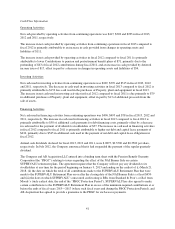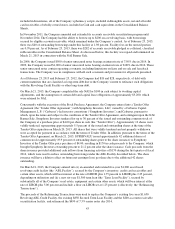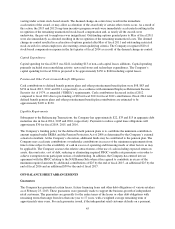Albertsons 2013 Annual Report Download - page 37
Download and view the complete annual report
Please find page 37 of the 2013 Albertsons annual report below. You can navigate through the pages in the report by either clicking on the pages listed below, or by using the keyword search tool below to find specific information within the annual report.including current period losses combined with a history of losses or a projection of continuing losses, a
significant decrease in the market value of an asset or the Company’s plans for store closures. When such events
or changes in circumstances occur, a recoverability test is performed by comparing projected undiscounted future
cash flows to the carrying value of the group of assets being tested.
If impairment is identified for long-lived assets to be held and used, the fair value is compared to the carrying
value of the group of assets and an impairment charge is recorded for the excess of the carrying value over the
fair value. For long-lived assets that are classified as assets held for sale, the Company recognizes impairment
charges for the excess of the carrying value plus estimated costs of disposal over the estimated fair value. Fair
value is based on current market values or discounted future cash flows using Level 3 inputs. The Company
estimates fair value based on the Company’s experience and knowledge of the market in which the property is
located and, when necessary, utilizes local real estate brokers. The Company’s estimate of undiscounted cash
flows attributable to the asset groups included only future cash flows that are directly associated with and that are
expected to arise as a direct result of the use and eventual disposition of the asset group. Long-lived asset
impairment charges are a component of Selling and administrative expenses in the Consolidated Statements of
Operations.
The Company groups long-lived assets with other assets at the lowest level for which identifiable cash flows are
largely independent of the cash flows of other assets, which historically has been at the geographic market level.
The Company reviewed its long-lived asset grouping policy during the fourth quarter of fiscal 2013. During the
review, the Company determined it would be more appropriate to evaluate long-lived assets for impairment at the
store level for certain geographic markets within the Save-A-Lot segment which continued to show higher
indicators of economic decline, and which led to revised operating market strategies. The Company determined
that impairment of the long-lived assets within this asset group had occurred based on reviewing estimated cash
flows, which were less than their carrying values. During the fourth quarter of fiscal 2013, based upon the results
of impairment testing which indicated the carrying value exceeded the fair value of the revised asset group, the
Company recorded a pre-tax non-cash impairment charge of approximately $8 related to a store level impairment
review and a charge related to a geographic market in the Company’s Save-A-Lot segment.
Due to the ongoing business transformation and highly competitive environment, the Company will continue to
evaluate its long-lived asset policy and current asset groups, to determine if additional modifications to the policy
are necessary. Future changes to the Company’s assessment of its long-lived asset policy and changes in
circumstances, operating results or other events may result in additional asset impairment testing and charges.
During fiscal 2013, the Company announced the closure of approximately 22 non-strategic stores within the
Save-A-Lot segment including the exit of a geographic market, resulting in an impairment of $16 related to these
stores’ long-lived assets. In addition, the Company recorded an impairment charge of $5 in the Independent
Business segment, based upon the results of impairment testing which indicated the carrying value exceeded the
fair value of a distribution center held and used in operations. Refer to Note 3—Reserves for Closed Properties
Property, Plant and Equipment-Related Impairment Charges in the Notes to Consolidated Financial Statements
included in Part II, Item 8 of this Annual Report on Form 10-K for additional information on reserve for closed
properties and Property, plant and equipment-related impairment charges.
The Company recognized Property, plant and equipment-related impairment charges of $251, $3 and $11 in
fiscal 2013, 2012 and 2011, respectively. During the fourth quarter of fiscal 2013, the executive management
team determined the Company would abandon certain capital projects in process, mainly related to software
under development, and would cease use of certain other software support tools, all within the Retail Food
segment, resulting in an impairment of $191.
Reserves for Closed Properties and Property, Plant and Equipment-Related Impairment Charges
The Company maintains reserves for costs associated with closures of retail stores, distribution centers and other
properties that are no longer being utilized in current operations. The Company provides for closed property
35


